 Multiple Choice Questions
Multiple Choice QuestionsE. coli takes 40 min. to duplicate its genome using a bi-directional mode of replication. If E. coli were to use uni-directional mode of replication to synthesize a full copy of DNA complementary to just one of the strands of the genome, it would take
40 min
80 min
20 min
60 min
Transcriptional regulation of trp operon by tryptophan inolves binding of tryptophan to
the repressor protein and inhibition of transcription by its interaction with the operator region.
RNA polymerase and inhibition of transcription.
The repressor protein leading to structural changes and its degradation by proteases.
the repressor protein leading to its interaction with the sigma subunit and inhibition of transcription.
Phosphorylation of eIF2 a subunits (at Ser 5I) leads to
inactivation of Met-tRNA, binding activity of eIF2B.
sequestration of eIF2B because of tight binding between eIF2 and eIF2B
degradation of eIF2B.
enhanced guanine exchange activity of eIF2B.
If a disease caused by an intracellular pathogen is associated with host anti-inflammatory response, which one of the following may lead to an effective therapeutic approach?
Treatment with TGF-b
Treatment with macrophage activating agent
Depletion of IFN-g from the system
Treatment with IL-4 and IL-10
only (a) and (b)
(b), (c) and (d)
only (a) and (d)
(a), (c) and (d)
In an attempt to increae the yield of a commerically important enzyme from natural isolate, several strateiges were adopted as follow:
(a) genome was selectively modified to increase yield.
(b) Reappraisal of culture requirements of the modified organism to increase yield.
(c) Induced mutants were screened and selected for organism synthesizing improved levels of the enzyme.
(d) Organism was genetically modified, so that it produces a factor that enchances stability of the enzyme.
Which of the following options represents strategies that are appropriate for the purpose?
(a), (b), (c) and (a)
(b) and (c) only
(a), (c) and (d) only
(a) and (b) only
Given below are four statements related to Agrobacterium-mediated transfer of T-DNA into plants cells:
(a) Production of single-stranded T-DNA by VirD1 and VirD2 proteins.
(b) interaction of VirE2 with VIP1 and VirE3.
(c) Use of VirB/VirD4 type IV selection system.
(d) Activation of VirA-VirG complex.
The correct sequences of events ( from earlies to latest) is:
(a)-(b)-(d)-(c)
(b)-(c)-(a)-(d)
(c)-(a)-(b)-(d)
(d)-(a)-(c)-(b)
Using interrupted mating, four Hfr starin were analysed for the sequences in which they transimitted a number of different gene to a F- strain. Each Hfr starin was found to transmit its genes in unique order as summarized in the table [ only the first five gene were scored].
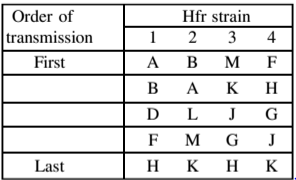
Which one of the following correctly represents the gene sequences in the orginal strain from which the Hfr strains were derived as well as the place of intergration and polarity of the F plasmid?
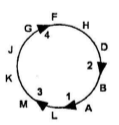
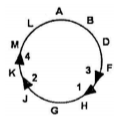
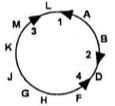
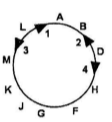
C.

Only one F factor is intergrated into each Hfr strains. Different Hfr strains have the F factor intergrated into the chromosome at different locations and in different orientations.
Therefore, Hfr strains differ with respect to where the transfer of donor gene begins and in what order donor gene transfer. So in this questions if analysis is done it clear that the sequences should be ABDFHGJKML ( Circular). Site of intergration of F-plasmid is between A and L (ABDFH- strain 1), between B and D (BALMK- strain 2) between M and L (MKJGH- starin 3) and between F and D (FHGJK- strain 4).
Monoclonal antibodies can be modified for better research and therapeutic application. Several such approaches are mentioned below (column A) along with their possible applicatins (column B).
| Column A | Column B |
| (a) Binding sites of the original mouse mAb are placed onto the Fe regions of human antibodies | (i)Abzyme |
| (b) Antibodies are modified by conjugation to toxin designed to kill cells to which the antibody will bind | (ii) Reduce side effect of xenogenic antibodies in immunotherapy |
| (c) Generation of mAb that specifically bind and stabilize the transition state of a chemical reaction | (iii) Immunotoxins |
Which one of the following options represents a correct combination of term in Column A and Column B?
| (a) | (b) | (c) |
| (i) | (ii) | (iii) |
| (ii) | (i) | (iii) |
| (iii) | (ii) | (i) |
| (ii) | (iii) | (i) |
Viruses adopt different strategies to supress immune response of the host. Which one of the following statements is NOT correct?
Human Immunodeficiency Virus (HIV) destroys CD4+T cells
Epstein-Barr Virus (EBV) produces a homolog of human IL-10.
Human influenza virus directly infects CD8+T cells
Human Cytomegalo Virus (CMV) establishes latent infection in bone marrow stem cells
